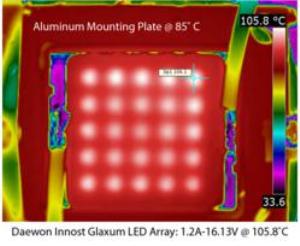Daewon Innost, a developer of Nano-Pore Silicon Substrate (NPSS) technology, has unveiled the Glaxum LED array portfolio of chip-on board (COB) modules. With 0.41°C/W thermal impedance, Glaxum arrays demonstrate unprecedented dissipation performance thanks to the proprietary NPSS technology.
 Thermal image of Daewon Innost's Glaxum module which performs at 0.41°C/W
Thermal image of Daewon Innost's Glaxum module which performs at 0.41°C/W
Glaxum arrays are made utilizing high-efficient 1-W LED chips. Daewon Innost devised the NPSS technology for LED modules in order to demonstrate superior thermal dissipation performance. The LED substrate is fabricated by using semiconductor lithography on silicon wafers to provide fine pitch interconnection between GaN LED chips, thus enabling 50 µ pitch spacing when compared to more than 300 µ used in current metal core printed circuit board (MCPCB).
The advantages offered by the NPSS technology over MCPCB include higher integration levels, better thermal performance, and favorable scaling, which reduces system costs when power levels rise. Models of the Glaxum NPSS modules range between 3.5 and 100 W. The models offered with lowest thermal impedance include the Glaxum-MCL-GL-CC-020-002 (cool white) and Glaxum-MCL-GL-WC-020-002 (warm white). Glaxum module’s tested voltage is 16.6 V and current value is 1.2 A.
Daewon Innost’s Chief Executive Officer, Sungyuk ‘Stephen’ Won informed that results of the independent test conducted by a major LED chip supplier demonstrate that the company’s LED modules have outclassed the thermal performance of today’s cutting-edge COB technology. The company’s Glaxum module operates at a temperature 12°C cooler when compared to previous COB module. Since every degree centigrade reduction in operating temperature results in an additional lifetime of 1000 h, the company’s cooler temperatures will thus enable longer operating life for LED arrays.